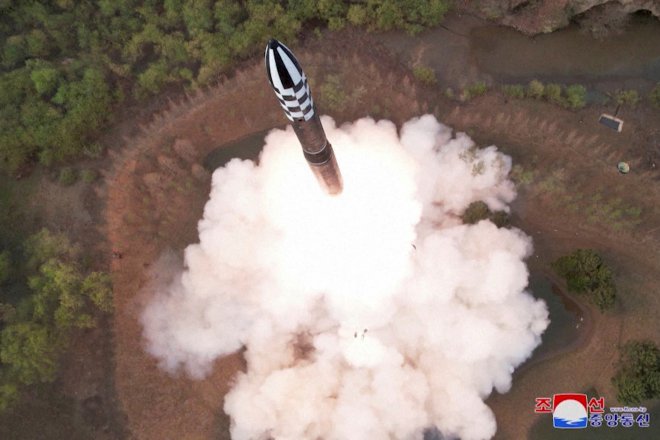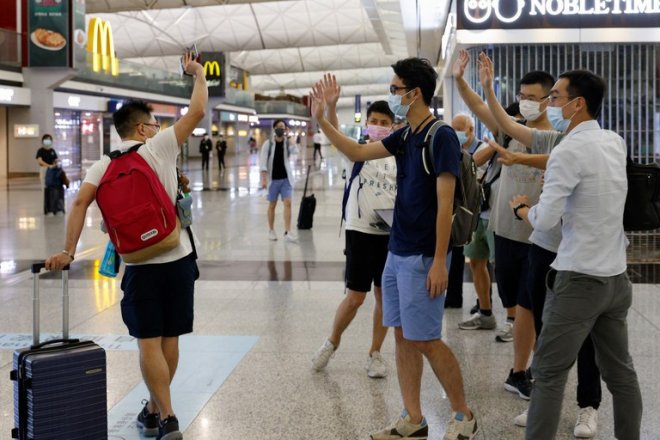North Korea claims launch of new solid-fuel Hwasong-18 ICBM
North Korea on Friday said it had successfully launched a new solid-fuel intercontinental ballistic missile, representing a significant upgrade to its arsenal that experts told Radio Free Asia would, once perfected, allow it to fire missiles with shorter wait times.The country’s leader Kim Jong Un oversaw the test launch on Thursday, and said that the new missile would reform North Korea’s strategic deterrence components and enable Pyongyang to more effectively respond with a nuclear counterattack, the state-run Korea Central News Agency reported. Kim said the technology would make a potential offensive military strategy more practical.
The new missile “constantly strikes extreme uneasiness and horror into [the enemy] by taking fatal and offensive counter-actions until they abandon their senseless thinking and reckless acts, thus making them feel regret and despair for their wrong choice by surely exposing them to an irresistible threat,” the report said.
Fired from a launch site near the capital Pyongyang, the new Hwasong-18 missile flew about 620 miles (1,000 kilometers), landing in waters east of the Korean peninsula, Reuters reported.
Experts told RFA’s Korean Service that although a solid-fuel rocket takes less time to prepare for launch, North Korea needs further testing to perfect the technology.
Pyongyang has been moving towards a solid-fuel missile propulsion system, with Kim Jong Un saying it was a goal for this year to have operational solid-fuel ICBMs, Ankit Panda, a senior fellow at the U.S.-based Carnegie Endowment for International Peace, told RFA’s Korean Service.
“If successfully developed, solid-propellant ICBMs would complicate wartime planning for the U.S.-South Korea alliance as these missiles would be much more responsive in a crisis,” he said. “Unlike liquid-propellant missiles, solid-fuel missiles do not need fueling immediately prior to use. North Korea will continue its developmental missile testing and exercises as the year continues.”
 A view of a test launch of a new solid-fuel intercontinental ballistic missile Hwasong-18 at an undisclosed location in this still image of a photo used in a video released by North Korea"s Korean Central News Agency (KCNA) April 14, 2023. Credit: KCNA via ReutersThe effectiveness of an ICBM is dependent on its survivability, said Joseph Dempsey, Research Associate for Defence and Military Analysis at the London-based International Institute for Strategic Studies.
A view of a test launch of a new solid-fuel intercontinental ballistic missile Hwasong-18 at an undisclosed location in this still image of a photo used in a video released by North Korea"s Korean Central News Agency (KCNA) April 14, 2023. Credit: KCNA via ReutersThe effectiveness of an ICBM is dependent on its survivability, said Joseph Dempsey, Research Associate for Defence and Military Analysis at the London-based International Institute for Strategic Studies.“Solid-fuel missiles are typically only more survivable than liquid-fuel counterparts in that they require less preparation to launch,” he said. “This means there is less time and visual indicators for an opposing force to react.”
He said that regardless of fuel type, the ability of a warhead to withstand reentry into Earth’s atmosphere was most important.
“To date all North Korea ICBM tests have been conducted at lofted trajectories. If launched at a more maximum range trajectory, the stresses and strains of reentry at a shallow angle over a longer period could pose additional challenges,” he said. “This is not to say it would not survive, just that that technical hurdle has not been physically demonstrated with a test launch.”
Increasing missile capability is a priority for the North Korean government, but not necessarily for attacks on South Korea or the U.S., said Patrick Cronin, Asia-Pacific security chair at the Washington-based Hudson Institute.
“A space launch is still expected and a nuclear test remains possible, but thus far North Korea has simply poured its limited resources into firing missiles that land in the sea,” he said. While this theoretically improves its ability to puncture allied air and missile defenses in a war, any aggressive use of missiles to destroy or kill poses an existential threat to the Kim regime.”
He said that the U.S, and its allies prefer peace through deterrence, but North Korea prefers military symbols over economic development.
Former acting U.S. Ambassador to South Korea Rob Rapson told RFA that if Thursday’s missile test indeed involved solid fuel, it’s another significant improvement in Pyongyang’s strategic capabilities.
“Whether or not it’s a game-changer technology with respect to defeating ROK and U.S. missile defenses is uncertain, but it certainly complicates the mission,” he said, adding that North Korea is likely to conduct additional tests ahead of the U.S.-ROK Summit in Washington on April 26 and the G7 Summit in mid-May.
“It still remains unclear as to whether North Korea will conduct its long-forecasted 7th nuclear test,” he said. “It’s been six years since the last one.”
In a phone call with RFA, Shin Jong-woo, a senior analyst at the Korean Defense Security Forum, said of Thursday’s launch that North Korea took steps to prevent the missile from inadvertently falling on Japan.
“This first test had a low altitude and a unique launch method, a normal launch for the first stage, and a high-angle launch for the second and third stages, which is believed to have been intended for range control, he said.
He also said that instead of launching the missile from the usual launch site in Sunan, where Pyongyang’s airport is located, the North Korean government chose a launch site in the outskirts of Pyongyang, in case things did not go as planned.
North Korea is preparing for Day of the Sun, a major holiday on Saturday that celebrates the birth of the nation’s founder Kim Il Sung, and a publicly known failure so close to the holiday would reflect badly on the government.
Further tests will likely try to fire the missile at a higher angle and an altitude of about 6,000 kilometers (3,700 miles) to showcase the missile’s maximum capabilities, he said.
“I think there is a high possibility that they will conduct a second launch ahead of the South Korea-U.S. summit."
Written in English by Eugene Whong.
[圖擷取自網路,如有疑問請私訊]
|
本篇 |
不想錯過? 請追蹤FB專頁! |
| 喜歡這篇嗎?快分享吧! |
相關文章
AsianNewsCast






















